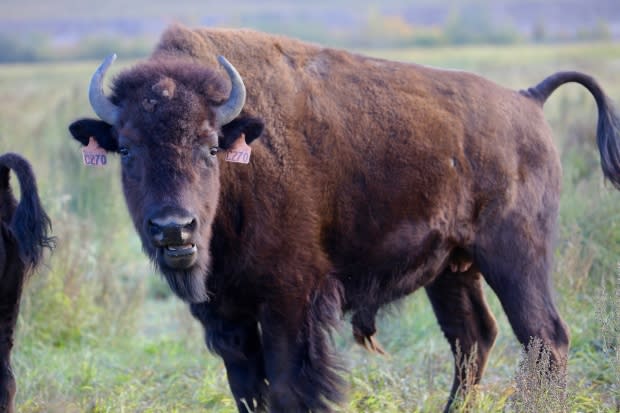Syncrude's 'bison keeper': 25 years of herding in the oilsands
When bison hear Brad Ramstead's pickup truck roaring down to their pasture, the normally skittish animals come near.
Ramstead has been the herd's caretaker for as long as wood bison have roamed Syncrude's lease north of Fort McMurray.
He's been there so long his family and friends call him many things — bison shepherd, bison keeper or buffalo man — to name a few.
"I get told by my wife, 'You are too close to them,'" Ramstead jokes.
But he's fine with those titles because, for him, the position is more than a job.
"When you have animals like this, it is a passion and a lifestyle," Ramstead said. "The animals do come first."
On Tuesday, Ramstead took media to see the bison herd up close as part of a number of events to mark the 25th anniversary of the herd's 1993 introduction.
Ramstead got a six-month contract at Syncrude in 1991 that turned into a lifelong vocation. He now works for the Fort McKay Group of Companies.
More than two decades ago, Ramstead and other Syncrude employees pioneered the bison ranch.

Originally, Syncrude wanted to introduce cattle as a way of studying how large mammals would fare on a depleted oilsands mine that had been filled in and planted with vegetation.
When the company took the idea to the nearby Fort McKay First Nation, its leaders told the oil company they would like to see bison returned to the region.
In 1993, 30 bison were introduced from Elk Island National Park, outside Edmonton, to a pasture site in the middle of Syncrude's Mildred Lake operation. Today, there are approximately 300 bison in the herd.
But there are still new challenges with the Syncrude bison.
One of those challenges is monitoring the health of a section of the herd that has transitioned to a new forested enclosure and determining whether the new pasture can sustain the bison. The new forested area will give the bison more land to roam and a different landscape.
Ramstead says one of the toughest parts of his job is not getting too emotionally invested in the bison.
He and his team avoid naming the animals because sometimes they must make tough decisions like euthanizing injured or sick bison.
"You try to move on. Obviously, it is not an easy thing to do," Ramstead said. "The animal's best interest is looked after. You make sure and do the correct thing."
Connect with David Thurton, CBC's Fort McMurray correspondent, on Facebook, Twitter, LinkedIn or email him at david.thurton@cbc.ca

